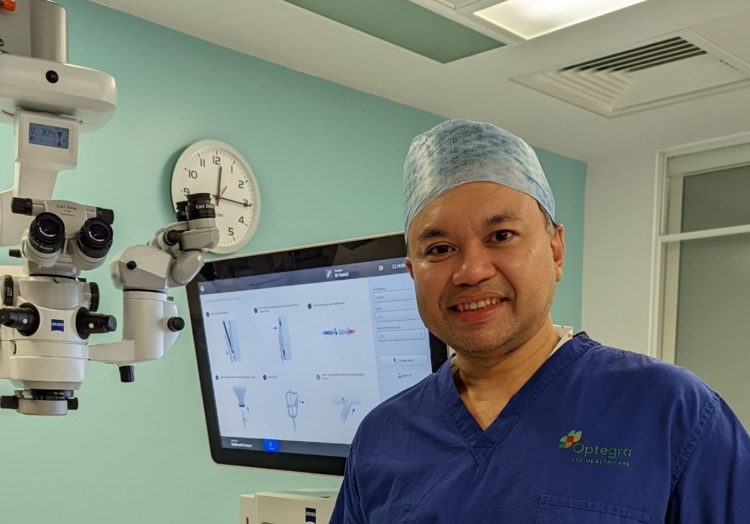One of the most frequently asked patient questions we get asked is, What is a cataract?
What Are Cataracts?
Cataracts are a common eye condition affecting the eye’s natural lens, which is located behind the iris (the coloured part of the eye). As we age, the lens gradually becomes less transparent, and this clouding, known as a cataract, can obstruct the passage of light, leading to blurry or hazy vision.
The good news is that cataracts are easily treatable through routine cataract surgery. Cataract surgery involves removing the cloudy lens and replacing it with an artificial intraocular lens (IOL), restoring clear vision. This procedure is safe, typically outpatient, and has a high success rate, allowing individuals to regain their quality of life and visual clarity. There is no reason at all to fear cataract surgery.
How Common Are Cataracts?
Cataracts are highly common and predominantly age-related. As we age, the risk of developing cataracts significantly increases. In fact, cataracts are one of the most prevalent age-related eye conditions. According to the World Health Organisation, cataracts are the leading cause of blindness globally. As a result, a large percentage of people over the age of 60 are likely to experience some degree of cataract development. However, cataracts can also develop due to other factors like genetics, certain medications, eye injuries, or underlying health conditions such as diabetes. Nonetheless, age-related cataracts are the most widespread and often occur as a natural part of the ageing process. This underscores the importance of regular eye examinations to detect, monitor, and manage cataracts early and ensure continued visual well-being.
What Does Cataract Vision Look Like?
When a person develops cataracts, their vision can be significantly affected, and the symptoms often progress gradually. Some common ways vision may appear when cataracts are present include:
Blurred Vision: Cataracts cause the eye’s lens to become cloudy, leading to a noticeable blurriness in the person’s vision. This blurriness can make it challenging to see detail near and far, including, for example, reading or recognising number plates.
Reduced Colour Perception: Cataracts can alter the way colours are perceived, often resulting in a faded or yellowish tint to the world. This can make it difficult to distinguish between certain colours.
Glare Sensitivity: Individuals with cataracts may become more sensitive to glare from bright lights, particularly when driving at night or in direct sunlight.
Halos Around Lights: Cataracts can create halos or rings around light sources, making it challenging to see clearly in low-light conditions or when looking at oncoming headlights.
Double Vision: Cataracts can sometimes cause double vision in one eye, which can be disorienting and interfere with daily activities.
Poor Night Vision: Cataracts often lead to poor night vision and difficulty seeing in dimly lit environments.
These visual disturbances can vary in severity, and the impact on a person’s daily life can differ from one individual to another.
For those who may suspect cataract development, it is important to be aware of the common symptoms of cataracts.
Fortunately, cataract surgery can effectively restore clear vision and alleviate these symptoms, making it an essential and widely performed procedure for those affected by cataracts.
People who notice symptoms of cataracts should see an eye care specialist as soon as possible

When Should You Seek Medical Assistance?
Cataracts can progress over time, so early diagnosis and timely medical intervention can prevent further deterioration of your vision and ensure the best possible outcome from cataract surgery, should it be necessary.
If you begin to notice some of the symptoms of cataracts described earlier in this article, it may be wise to seek help.
During an appointment with an eye specialist to check for cataracts, several key steps are typically involved. First, the specialist will gather your medical history and discuss any vision-related symptoms you may have been experiencing. They will then perform a series of eye examinations, which may include:
Visual Acuity Test: This standard eye chart test assesses your ability to see and identify letters or symbols at various distances, helping the specialist determine the clarity of your vision.
Slit-Lamp Examination: A slit-lamp is a special microscope that allows the doctor to examine the front of your eye, including the cornea and lens, under magnification to detect any signs of cataracts.
Dilated Eye Exam: The specialist may administer eye drops to dilate your pupils, which enables a more comprehensive view of the lens and retina, helping to identify the presence and severity of cataracts.
Visual Field Test: Cataracts can impact your visual field; this routine test can identify areas of vision affected by cataracts.
Based on the findings from these examinations, the eye specialist can make a diagnosis and discuss potential treatment options, which may include cataract surgery if the cataracts are significantly affecting your vision. Regular follow-up appointments are often scheduled to monitor cataract progression, if present, and to ensure appropriate management.
How Are Cataracts Removed?
Cataracts are typically removed through surgery. This is the most effective way to remove cataracts and restore clear vision. The procedure is quick and generally pain-free due to the use of local anaesthesia and sedation.
During cataract surgery, the cloudy natural lens is removed and replaced with an artificial intraocular lens (IOL) to improve vision. At Optegra, we use the latest techniques, and technologies for your cataract surgery.
Patients often experience improved vision shortly after the surgery and can resume their daily activities with minimal downtime, ensuring a successful outcome from this routine procedure.
You’re in Safe Hands with Our Cataract Surgeons
Each of our consultants is a respected expert in their specialised field and wholeheartedly dedicated to delivering top-tier eye care for our patients. Every Optegra consultant boasts comprehensive training within the NHS and holds the distinguished title of Fellow of the Royal College of Ophthalmologists (RCO).
Our team of expert surgeons has an extensive track record, having successfully performed thousands of cataract treatment surgeries. They are also fortified by our dedicated ophthalmic support teams, ensuring your safety and well-being, which are our top priorities.
What next? Get in Touch for Free, No-Obligation Advice.
At Optegra, we carry out tens of thousands of cataract procedures each year, with an impressive success rate of 99.6%. Learn more about cataract surgery at Optegra or book a no-obligation, free consultation for expert help and advice.

By Author: Amir Hamid
Mr. Amir Hamid is a Clinical Lead for Vision Correction and an expert refractive surgeon, based in London.
Medically Reviewed Date: 7th June 2024
